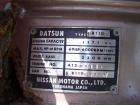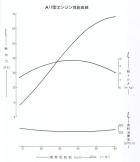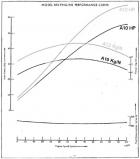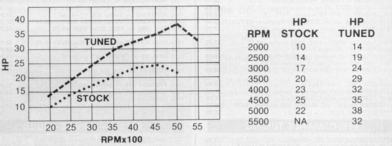A broad overview of Datsun 1200 Performance
NOTE: Power ratings vary by country and year. Check the underhood plate in your 1200. Most plates have the SAE* rating (see below) of 68 or 69 hp.

Contents |
Datsun 1200 Performance
Engine Ratings
A12A JAPAN 1980 (H8500) 70PS @ 6000 RPM 0.12 torque
| year | engine | HP | rwhp | Kw | @rpm | torque (lb-ft) | N-m | @rpm | Notes |
| 1971 | A12 | 69 | 40 | 51 | 6000 | 70 | 97 | 3600 | rear-wheel HP |
| A12 used | 25 | 30 (est) | Supertune Dyno | ||||||
| A12 tuned | 38 | 44 (est) | Supertune Dyno | ||||||
| 1971 | A12 USA | 69 | 51 | 6000 | 70 | 97 | 3600 | SAE Gross HP (?) | |
| 1972 | A12 USA | 68 | 51 | 6000 | 69 | 96 | 3600 | SAE Net HP (?) | |
| 1972 | A12GX | 83 | 62 | 6400 | 72 | 100 | 4400 | JIS hp rating | |
| 1973 | A12SSS | 90 | 55 | 67 | rear-wheel HP | ||||
| 1973 | Datsun Rotary | 120 | 89 | 6500 | 116 | 160 | 4400 | Wheels Magazine | |
| 1976 | A14 FED | 70 | 52 | 1976 USA ad, 4-speed | |||||
| 1976 | A14 CAL | 68 | 51 | 1976 USA ad, 4-speed | |||||
| 1980 | A14 | 65 | 48 | 5600 | US Wagon (from plate) | ||||
| 1980 | A14 FED | 80 | 60 | 6000 | US model (from plate) | ||||
| 1974 | A12GX | 63 | 46.8 | 6224 | 60 | 83 | 3273 | 1200GXman | |
| A15 race | 114 | 85.0111856823266 | 6965 | 90 (est) | 124 (est) | 6600 | Steveo1000's A15 | ||
| A15 race | 111 | 83 | 7900 | 86 | 118.938 | 5900 | Steveo's A15 | ||
| 1997 | A14 | 63 | 47 | 6000 | B140 Review | ||||
| 2004-2006 | A14 | 63 | 47 | 6000 | 70 | 97 | 2500 | Nissan South Africa | |
| A14? | 99 | Dattoman_1000's engine | |||||||
| A14+ | 104 | 7248 | Rally1200's A | ||||||
| A12 turbo | 69 | stock block turbo | |||||||
| A15ETT | 102 | 76rw | twin-turbo | ||||||
| A15 | 69 | 5370 (est) | mild build-up |
| RPM | RWHP Stock | Torque lb.ft. (est) | RWHP Tuned | Torque lb.ft. (est) |
| 2000 | 10 | 26 | 14 | 37 |
| 2500 | 14 | 29 | 19 | 40 |
| 3000 | 17 | 30 | 24 | 42 |
| 3500 | 20 | 30 | 29 | 44 |
| 4000 | 23 | 30 | 32 | 42 |
| 4500 | 25 | 29 | 35 | 41 |
| 5000 | 22 | 23 | 38 | 40 |
| 5500 | NA | NA | 32 | 31 |
156 HP Dave Patten's A15 SCCA race engine

- The 156HP pull was without the restrictor SCCA requires. The engine has around 15:1 compression and runs dual 45 Weber DCOE carbs w/32mm chokes.
- The Low HP run was with the required 25mm restrictor, it was with a slightly cold engine and we were getting some pinging on that set-up. When we switched to the 24mm restrictor it was the 3&4 pulls with a more evenly warmed engine, no pinging and that netted the 142HP pull.
Acceleration Performance
Quote:
turns 0-60 in less than 15 seconds
Quote:
Road & Track Road Test (November, 1970)
0-60 mph 15.1 secs 1/4 mile 19.6 secs @ 67 mph lb/hp 29.5 80 mph stop 302 ft
Quote:
ACCELERATION [1200 SSS] (Standard 1200 as tested October 1971 given in brackets):.. 0 - 60mph ............. 11.9s . (14.0s) .. Standing quarter mile . 18.1s . (18.8s)
MOTORMAN magazine
Consumer Reports 1971 September Road Test
- 1/4 mile ... 21.5 sec @ 66 mph
- 0-60 mph ... 18 sec
Mechanix Illustrated 1973 article
- 0 to 60 mph: 19.8 sec.
- 1/4 mile: 21.6 sec.
Datsun 1200 Salesman Book, Nissan 1970
- SS 1/4 mile: 18.6 seconds (pg 52)
Ddgonzal's timeslip (stock engine, but smaller diameter tires)
- SS 1/4 mile: 19.887 seconds
0-60 Comparison to Other Vehicles
Comparison to Contemporary Vehicles
`The Datsun 1200 was not slow in comparison with other economy cars of the period. For example, it was faster than all these cars in 0-60mph:
- 1973 Datsun 1200 16.5
<li>1971 Chevrolet Vega 2300 16.5
<li>1972 Dodge Colt Wagon 16.7
<li>1976 Datsun B210 (4spd) 17.2
<li>1976 Datsun B210 (5spd) 17.4
<li>1976 Renault R-5 17.4
<li>1972 Volkswagen Wagon 17.7
<li>1974 AMC Gremlin 17.8
<li>1975 Datsun B210 17.8
<li>1974 Datsun B210 sedan 17.9
<li>1979 Volkswagen Rabbit (Turbo Diesal) 17.9
<li>1971 Ford Pinto 1600 18
<li>1976 Chevrolet Chevette Rallye 19.7</ul>
... Yet slower than these:
- <li>1974 Honda Civic 15.7
<li>1980 Chevrolet Chevette 15.8
<li>1972 Fiat 128 SL 16
<li>1972 Ford Pinto Wagon 16
<li>1972 Opel Wagon 16
<li>1974 Toyota Corolla 1200 16.1
Comparison to Modern Vehicles
What about the Modern Era? To bring the 1200 into the modern performance era, 0-60 times would have to be improved. These are among the slowest cars of the '90s (yet their 1/4 mile times are similar to the 1200's):
-
<li>1993 Subaru Impreza L Wagon 12.7
<li>1995 Geo Metro LSi 12.7
<li>1990 Hyundai Excel GLS 12.5
<li>1991 Toyota Previa LE 12.5
<li>1996 Plymouth Breeze (auto) 12.5
reference: http://www.angelfire.com/pa3/ford/performance1.htmTop Speed
I would guess the top speed is about 90 mph (144 kmh). The speedometer error in the Road & Track test vehicle was 7% off. It read out faster than the actual vehicle speed. This inflates speed, fuel mileage and distance traveled (if you go by the speedometer). My first 1200 speedo was off about 10%. My current speedo is off ~7.5%.
Top Speed: 90+ mph Mechanix Illustrated 1973 article
The FIA docs states a top speed of 140 kmh, and 150 kmh for the high-compression engine.
To test the top-speed you need a long (5-mile) track or a banked oval. Mechanix Illustrated tested a stock but broken-in 1200 in 1973 on the Daytona Speedway:
Quote:
topping out at a shade over 90 mph
MOTORMAN magazine out of New Zealand tested both a regular 1200 and a 1200 SSS and note this:
Quote:
We didn't take the 0-90mph time with the standard car because it was near the Datsun's top speed, but the SSS version took half a minute to reach this velocity, and continued to pull strongly to its maximum of 100mph.
Braking Performance
The disc-brake Datsun 1200 had decent brakes:
FROM 60 MPH ... 160 feet... with some or all wheels locked ... 140 feet
Consumer Reports 1971 September Road Test
It had significantly better braking performance than the Datsun 510. It was similar to the 240Z (the 1200 beat the 240Z when fully loaded).
Stopping distance in feet from 60 mph: 190-195 feet
Click for Nissan braking specifications USA 1971 Nissan Consumer Information document
USA 1971 Nissan Consumer Information document
Braking Comparison with Period Cars
Compared to its time period, the 1200's brakes weren't necessarily bad: <li>disc-brake Datsun 1200: 190 ft <li>1964 Pontiac GTO: 197 ft <li>1970 LS-6 Chevelle: 194 ft
It was also better than the Fiat 850 and the same as the Opel Kadette.
1973 Vehicle Stopping Distance
Source: 1973 Datsun Consumer Information
Stop from 60 mph
Light Load
- 179 ft 240-Z
- 176 ft 610
- 190 ft 610 Wagon
- 195 ft 1200
- 226 ft 510
Heavy Load
- 194 ft 240-Z
- 200 ft 610
- 216 ft 610 Wagon
- 190 ft 1200
- 196 ft 510
Braking Comparison with Modern Cars
The braking performance doesn't compare well with todays vehicles: <li>disc-brake Datsun 1200: 190 ft <li>2002 Mitsu Lancer: 144 ft <li>2002 Toyota Camry: 118 ft
Weight
See main article: Weight
Fuel Economy
See Fuel_economy

General Information
How much horsepower does my engine have?
Engine ratings can vary from the engine in your car:
- Different countries, different ratings
- Different emissions controls, camshafts and other parts
- Production tolerances. Your engine might have a little more or a little less than advertised
- Manufacturer reports may not have been accurate
- Ratings prior to 1971 cannot be compared directly to newer ratings (to get a ballpark comparison, subtract 20% from the gross rating)
The best way to measure your engine is to put it on a dyno. Use the same air cleaner and exhaust and all accessories, or use a correction factor to estimate the Net hp from the Gross hp.Hp can also be estimated from top speed (if a lot of other things are known, like the aerodynamic numbers or the car), or from 1/4 mile drag race elapsed time.
Horsepower Ratings Standards
Note that engines are not rated by independent testers -- it's the manufacturer's word. They are supposed to follow a standard though, or they could be held liable for false advertising.
- Japan: In Japan, the JIS standard is used
- Europe: The DIN rating in Europe. This is slightly higher numbers than SAE (for the same engine. 70 DIN = 69 SAE)
- Asia: In Asia, Kw is used. 69 hp = 51 kw
- US: In United States, SAE ratings are use (see below)
What is horsepower?
Horsepower is a measurement of the engine's ability to perform work. For example, the work of accelerating a car through a 1/4 track.
Note that the horsepower "number" is independent of weight. It is simply the measure of work over time.
Horsepower is a computed factor based on the torque measured on an engine dynomometer. Torque is just the force of the engine, but doesn't say how much work is getting done. Horsepower is the work made possible by the rotating engine, so RPM is also a factor along with the torque in determining power.
The HP "rating" is a static setting for a certain condition (like full throttle, maximum engine load at a certain RPM) and so only tells a little bit about the engine. An engine performance curve, generated by by taking torque readings at a sequence of RPMs, will give more insight into the performance of a car.
For a detailed discussion of horsepower and torque and how they relate to cars, see Vettenet's Torque and Horsepower Primer
Power and Top Speed
It takes a certain amount of power to push a particular car through the air due to aerodyamics, and friction of the tires agains the road. For a Datsun 1200 coupe or sedan, it takes about 35 rear-wheel-horsepower to push the car along at 90mph (140 kph).
Torque and HP conversions
Nm = ft. lbs. * 1.38273
SAE HP = kW * 1.341
Torque = Horsepower x 5252 / RPM
What is SAE?
SAE is the Society of Automotive Engineers. Their standard is used by the auto manufacturers. Prior to about 1972, SAE gross ratings (aka bph - brake horespower) was used. This was the engine without accessories and was was not standardized, so different manufacturers rated it differently. Since 1972 in America the Net SAE rating has been used per standard J1349. This is the engine with all accessories (alternator, air cleaner, etc) as fitted in the car, so it is more realistic. Both SAE net and gross ratings are based on an engine dynamometer (not a rear-wheel dyno). The "brake" is referring to the dyno's putting a retarding force on the engine.
SAE NET HP is more powerful than Gross HP. So be cautious about comparing old advertised HP ratings to modern advertised ratings.
In 2005, the SAE introduced "SAE Certified Power" with SAE J2723. To attain certification the test must follow the SAE standard in question, take place in a ISO9000/9002 certified facility and be witnessed by an SAE approved third party. A few manufacturers such switched to the new ratings immediately, which raised the HP for some engines, but fell for most.
To Recap:
- SAE Gross HP - used by american auto manufacturers prior to 1972, HP at flywheel without engine accessories (unrealistic)
- SAE NET HP - used from 1972, which is actual HP at flywheel as fitted in the car (realistic)
- SAE Certified HP - used by some since 2005 (accurate)
For more details, see wikipedia:Horspower in the section Society of Automotive EngineersRear Wheel Horsepower
With rear-wheel HP there are standards sometimes used, but the "chassis" dynos which measure rwhp are notoriously uncalibrated. So comparing rwhp figures is to be taken with a grain of salt.
If the horsepower is measured according to certain standards, then it tells you something about how the HP number was arrived at. For a long time, new car manufacturers have been using JIS, DIN or SAE measurements to ensure the number is accurate even on different engine dynos. For 2007, a new improved SAE standard is making the measurement even more precise. A lot of engines were de-rated about 5 HP (e.g. Honda) while Fords were generally unchanged and a few even were uprated a touch.
This means you can generally have good faith in new-car manufacturer's power number (as least in USA where the new standard is used).
When measuring rwhp, the dyno operator needs to factor in an appropriate loading weight for the dyno rollers. If done correctly, the resulting HP number should theoretically stand alone, independent of weight.
Another way to look at it, theoretically 200 HP is 200 HP, whether put out by a turbine engine, rotary engine or piston engine. Or even an electric motor. Yet as others pointed it, the HP alone doesn't tell you how fast a car will accelerate. For that you need other factors, especially weight (lighter cars accelerate faster than heavy cars with the same engine). And then suspension setup has a huge effect on the first 60 feet of acceleration (cars that spin the tires too much accelerate slower, all else being equal). For top speed, HP alone is a good indicator, while the "power band" (average hp over a wide RPM range) affects acceleration: for example a supercharged engine which typically makes high power at low, medium and higher RPM will out-accelerate a modified engine of the same size -- even when both make the same peak HP (this is because modified non-turbo/non-blower engines make little HP at low RPM).
Size Comparison
Size is not a performance item, but it is the single most important factor for weight, which is directly related to performance. Less weight = Faster acceleration.
Overall Length (Coupe, USA models)
- Fortwo: 2499 mm, 98 in (8' 2")
- Mini: 3630 mm, 143 in (11'9")
- Mini: 3700 mm, 148 in (12'4") (2007 model)
- B110: 3825 mm, 150 in (12'6")
- B210: 4065 mm, 160 in (13'4")
- B310: 4190 mm, 165 in (13'9")
Overall Width: (Coupe, USA models)- Fortwo: 1514 mm, 59.6 in (5'0")
- B110: 1515 mm, 59.6 in (5'0")
- B210: 1545 mm, 60.8 in (5'1")
- B310: 1580 mm, 62.2 in (5'2")
- Mini: 1690 mm, 66.5 in (5'6")

![[Datsun 1200 encyclopedia]](/wiki/upload/wiki.png)





